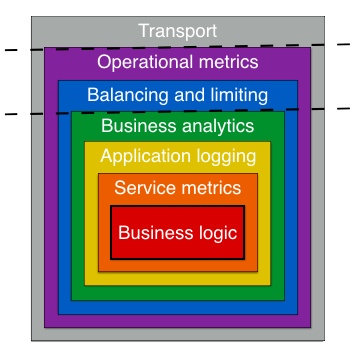Go kit - Frequently asked questions https://gokit.io/faq/
Architecture and design
Introduction — Understanding Go kit key concepts
If you’re coming from Symfony (PHP), Rails (Ruby), Django (Python), or one of the many popular MVC-style frameworks out there, the first thing you should know is that Go kit is not an MVC framework. Instead, Go kit services are laid out in three layers:
- Transport layer
- Endpoint layer
- Service layer
Requests enter the service at layer 1, flow down to layer 3, and responses take the reverse course.
This may be a bit of an adjustment, but once you grok the concepts, you should see that the Go kit design is well-suited for modern software design: both microservices and so-called elegantmonoliths.
Transports — What are Go kit transports?
The transport domain is bound to concrete transports like HTTP or gRPC. In a world where microservices may support one or more transports, this is very powerful; you can support a legacy HTTP API and a newer RPC service, all in a single microservice.
When implementing a REST-ish HTTP API, your routing is defined within a HTTP transport. It’s most common to see routes defined in a HTTP Router function like this:
r.Methods("POST").Path("/profiles/").Handler(httptransport.NewServer(
e.PostProfileEndpoint,
decodePostProfileRequest,
encodeResponse,
options...,
))
Endpoints — What are Go kit endpoints?
An endpoint is like an action/handler on a controller; it’s where safety and antifragile logic lives. If you implement two transports (HTTP and gRPC), you might have two methods of sending requests to the same endpoint.
Services — What is a Go kit service?
Services are where all of the business logic is implemented. A service usually glues together multiple endpoints. In Go kit, services are typically modeled as interfaces, and implementations of those interfaces contain the business logic. Go kit services should strive to abide the Clean Architecture or the Hexagonal Architecture. That is, the business logic should have no knowledge of endpoint- or especially transport-domain concepts: your service shouldn’t know anything about HTTP headers, or gRPC error codes.
Middlewares — What are middlewares, in Go kit?
Go kit tries to enforce a strict separation of concerns through use of the middleware (or decorator) pattern. Middlewares can wrap endpoints or services to add functionality, such as logging, rate limiting, load balancing, or distributed tracing. It’s common to chain multiple middlewares around an endpoint or service.

Putting all these concepts together, we see that Go kit microservices are modeled like an onion, with many layers. The layers can be grouped into our three domains. The innermost service domain is where everything is based on your specific service definition, and where all of the business logic is implemented. The middle endpoint domain is where each method of your service is abstracted to the generic endpoint.Endpoint, and where safety and antifragile logic is implemented. Finally, the outermost transport domain is where endpoints are bound to concrete transports like HTTP or gRPC.
You implement the core business logic by defining an interface for your service and providing a concrete implementation. Then, you write service middlewares to provide additional functionality, like logging, analytics, instrumentation — anything that needs knowledge of your business domain.
Go kit provides endpoint and transport domain middlewares, for functionality like rate limiting, circuit breaking, load balancing, and distributed tracing — all of which are generally agnostic to your business domain.
In short, Go kit tries to enforce strict separation of concerns through studious use of the middleware (or decorator) pattern.